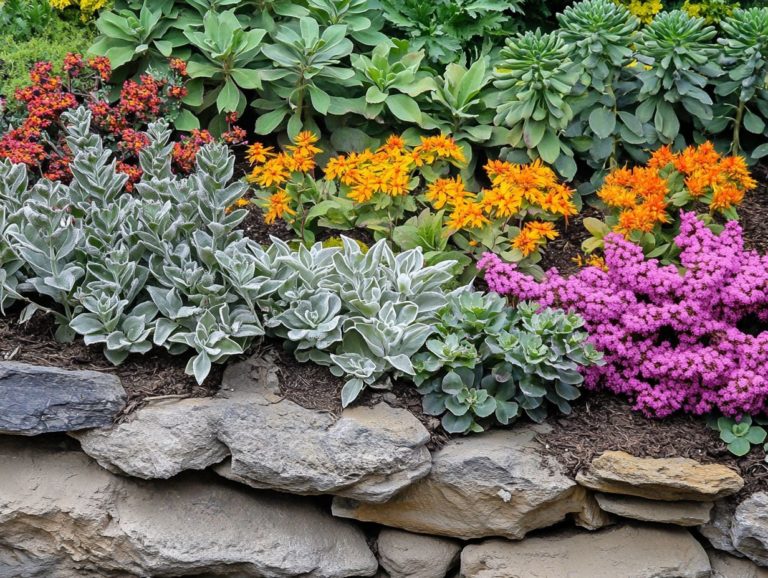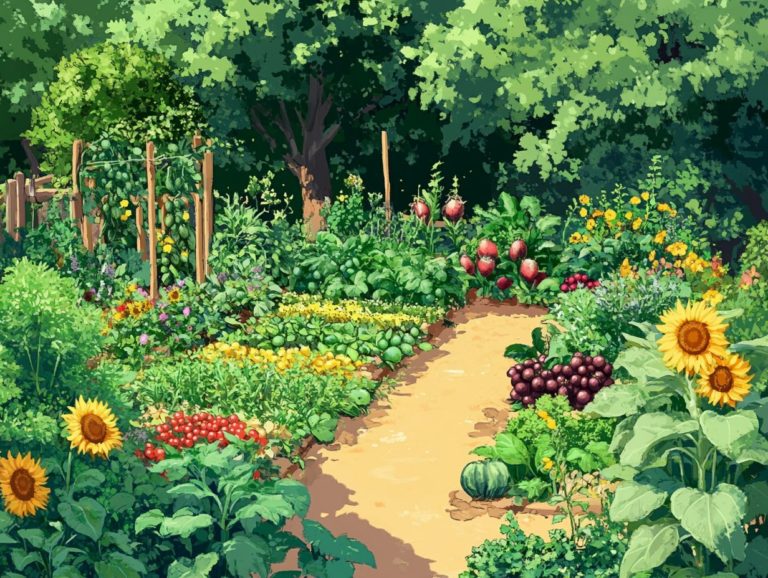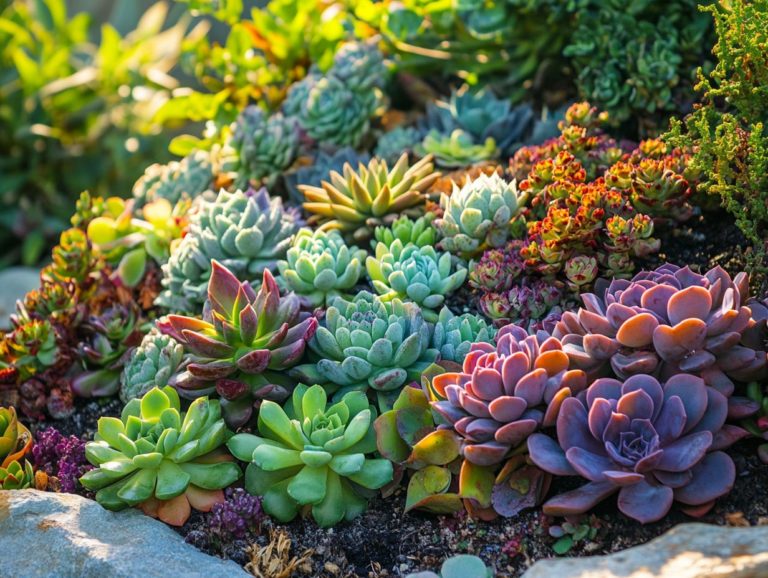“How to Choose Plants for a Herb Spiral”
Herb spirals are more than just a visual delight; they’re an incredibly efficient way for you to grow a diverse range of herbs in a compact space.
This guide will equip you with everything you need to know about creating your very own herb spiral. You ll discover the numerous benefits it offers, how to choose the right plants suited to your climate and growing conditions, and which herbs thrive best in this unique setup.
You’ll find practical steps for designing, building, and maintaining your spiral, along with crucial advice on common pitfalls to steer clear of.
Regardless of whether you re a seasoned gardener or just dipping your toes into the world of cultivation, this information will empower you to nurture a vibrant herb spiral that is both stunning and productive.
Contents
- Key Takeaways:
- What is a Herb Spiral?
- Factors to Consider when Choosing Plants
- Types of Herbs to Include in a Herb Spiral
- Designing and Building a Herb Spiral
- Maintaining a Herb Spiral
- Common Mistakes to Avoid
- Frequently Asked Questions
- What s a herb spiral, and why is it perfect for my garden?
- What factors should I consider when choosing plants for a herb spiral?
- Can I choose any type of herb for my spiral?
- Do I need to choose both annual and perennial herbs for my spiral?
- Is it possible to grow a herb spiral indoors?
- Can I choose herbs for my spiral based on their medicinal properties?
Key Takeaways:
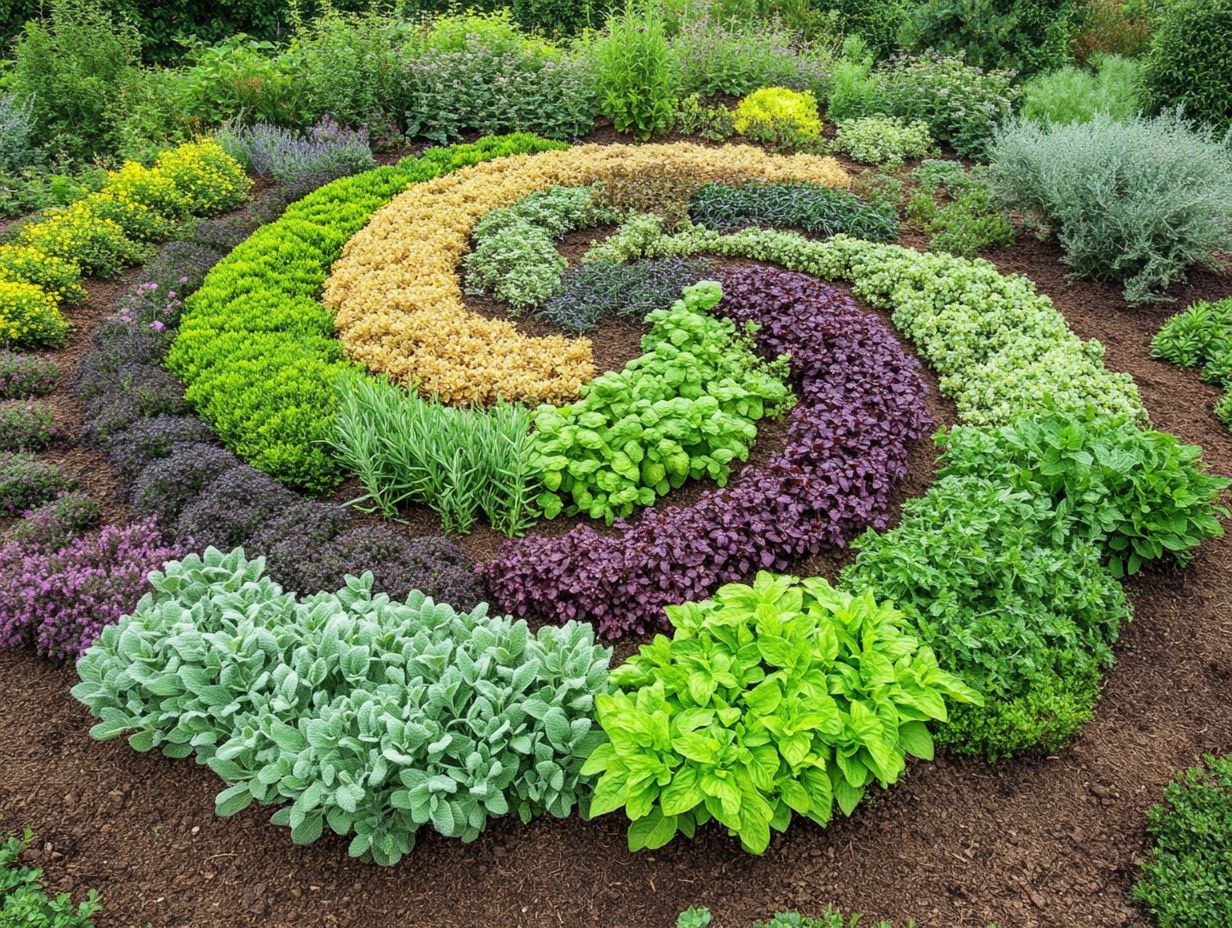
- A herb spiral is a raised garden bed that maximizes space and allows for easy access to different herbs. It offers many benefits such as efficient use of space, better drainage, and easier maintenance.
- When choosing plants for a herb spiral, consider your climate and growing conditions, as well as herb compatibility and companion planting. This will ensure healthy and thriving herbs.
- Culinary and medicinal herbs are great choices for a herb spiral. They provide both flavor and health benefits. Consider incorporating a variety of herbs to create a diverse and functional spiral.
What is a Herb Spiral?
A herb spiral is an innovative gardening technique that cleverly combines vertical and horizontal space to maximize the growth of a diverse array of herbs within a compact area.
This structure employs varying elevations to create unique micro-climates, or small areas with different weather conditions, providing optimal conditions for Mediterranean herbs like sage, rosemary, and thyme.
By constructing a herb spiral, you ll easily capture water and nutrients, ensuring your herb garden flourishes in both sunny and shaded spots.
This method not only promotes biodiversity but also elevates the aesthetics of your outdoor space, making it a beloved choice among permaculture enthusiasts.
Definition and Benefits
The herb spiral is an inventive gardening design that beautifully maximizes space while promoting biodiversity, allowing different plants to flourish under their preferred conditions.
This remarkable structure enhances drainage crucial for many Mediterranean herbs that thrive in well-drained soil to prevent root rot. Its unique spiral shape creates microclimates, facilitating efficient watering. The upper levels dry out more quickly, while the lower sections retain moisture, perfectly catering to the diverse needs of various herbs.
By cultivating a wide array of Mediterranean plants, such as rosemary, thyme, and oregano, in a compact area, you can create a lush and fragrant garden that not only boosts your yield but also enhances the visual allure of your outdoor space.
Factors to Consider when Choosing Plants
When crafting a successful herb spiral, your choice of plants is paramount. It requires good knowledge of various factors, including climate, growing conditions, and the compatibility of different plants.
Choose wisely to create a thriving garden that not only looks beautiful but also flourishes harmoniously.
Climate and Growing Conditions
Understanding the climate and growing conditions is essential for you to cultivate a thriving herb spiral, especially when it comes to Mediterranean herbs that crave sunny spots and well-drained soil.
In this distinctive gardening approach, local climate factors are pivotal. The varying elevations within the spiral create distinct micro-climates, allowing you to support a diverse array of herb types. For example, the upper sections bask in the most sunlight, making them perfect for sun-loving herbs like rosemary and thyme. Meanwhile, the lower areas retain moisture, providing an ideal environment for moisture-loving varieties such as mint and parsley.
Don t overlook the importance of incorporating quality soil and compost. This not only enhances drainage but also boosts nutrient availability, ensuring that each herb can thrive in its unique growing conditions.
Herb Compatibility and Companion Planting
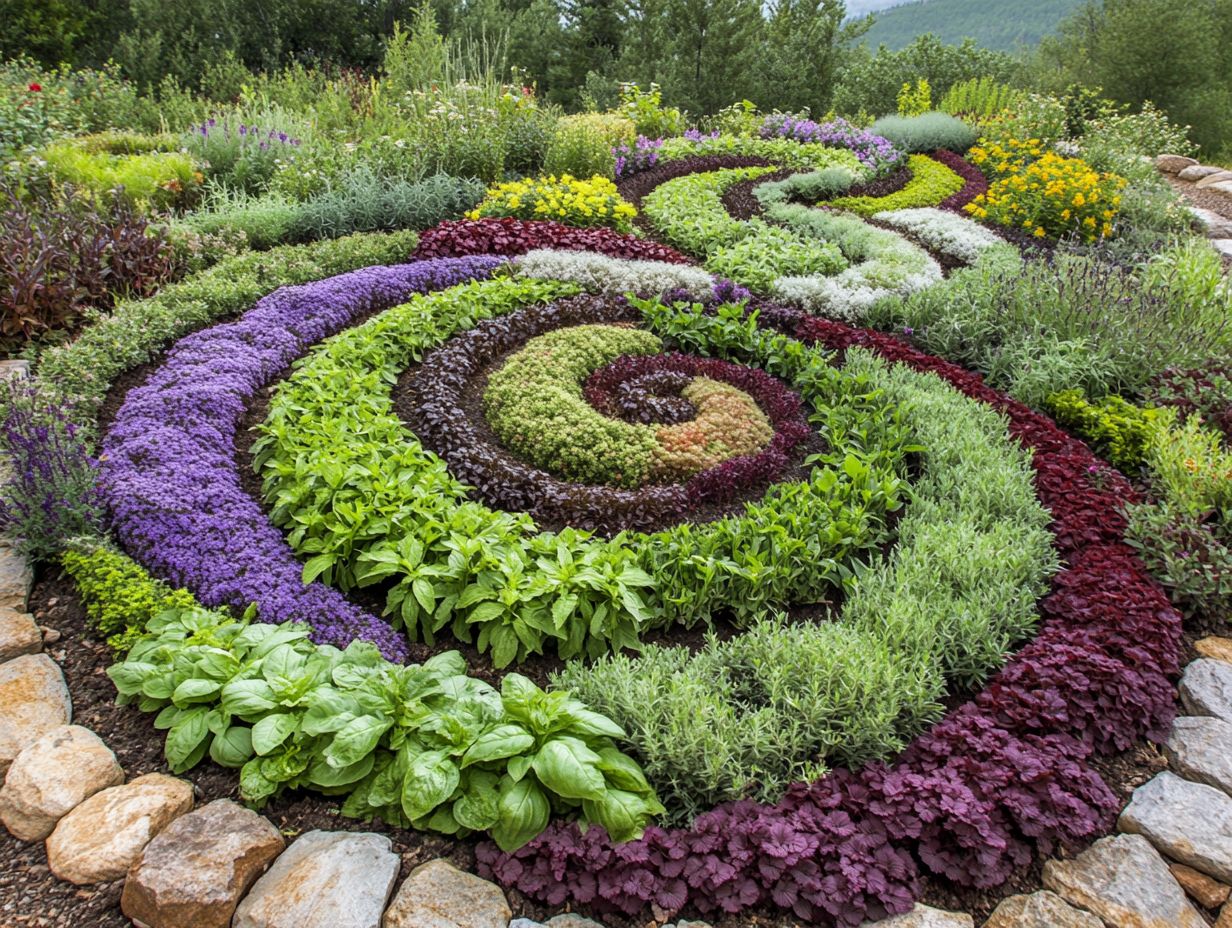
Choosing compatible herbs is essential for your herb spiral. Some plants flourish together, while others, like the mint family, can easily overshadow their neighbors.
Mastering the art of companion planting can elevate growth and fend off pests. This creates a harmonious ecosystem in your garden. For example, rosemary and thyme, both Mediterranean herbs, complement each other splendidly; they share a preference for well-drained soil and full sun. This sets the stage for a thriving, aromatic retreat.
Incorporating herbs like basil and oregano can further improve plant health. Basil naturally repels harmful insects, while oregano attracts beneficial pollinators.
However, it s crucial to steer clear of invasive species like certain types of mint or lemon balm. These can easily overwhelm competing plants and disrupt the delicate balance you aim to maintain in your herb spiral.
Types of Herbs to Include in a Herb Spiral
A carefully designed herb spiral can encompass a delightful array of herbs, with a particular emphasis on both culinary and medicinal varieties. This approach enriches the garden’s diversity and elevates its practical utility, allowing you to enjoy the best of both worlds.
Culinary Herbs
Culinary herbs are essential in any herb spiral, infusing your dishes with fresh flavors and captivating aromas.
Consider herbs like basil. Basil flourishes in warm climates and well-draining soil, and its fragrant leaves are a star ingredient in pesto and salads.
Cilantro and summer savory also enhance the taste of your meals. Cilantro thrives in cooler weather and adds a zesty kick to salsas and curries. Summer savory, known for its earthy, peppery flavor, grows best in sunny spots and pairs beautifully with beans and meats.
Each of these herbs has its own unique characteristics, transforming your everyday cooking into a delightful culinary adventure.
Medicinal Herbs
Medicinal herbs also offer culinary delights and provide a wealth of health benefits. They are a superb addition to any herb spiral.
Exciting plants like fennel and Russian tarragon not only lift your dishes but also boost your health. Fennel, known for its soothing properties, is often utilized in natural remedies for digestive concerns and can be found in various creams and oils due to its anti-inflammatory effects.
Russian tarragon is adored for its aromatic profile and its potential to promote skin rejuvenation. It’s a favored ingredient in herbal formulations that target signs of aging.
By incorporating these herbs into your routine, you can uncover a spectrum of natural solutions that nourish your body and enhance your overall wellness.
Designing and Building a Herb Spiral
Designing and constructing a herb spiral requires careful planning and thoughtful material selection. This allows you to create a structure that is both functional and visually appealing, ultimately enriching your garden s beauty.
Start planning your herb spiral today for a vibrant garden tomorrow!
Materials and Steps for Construction
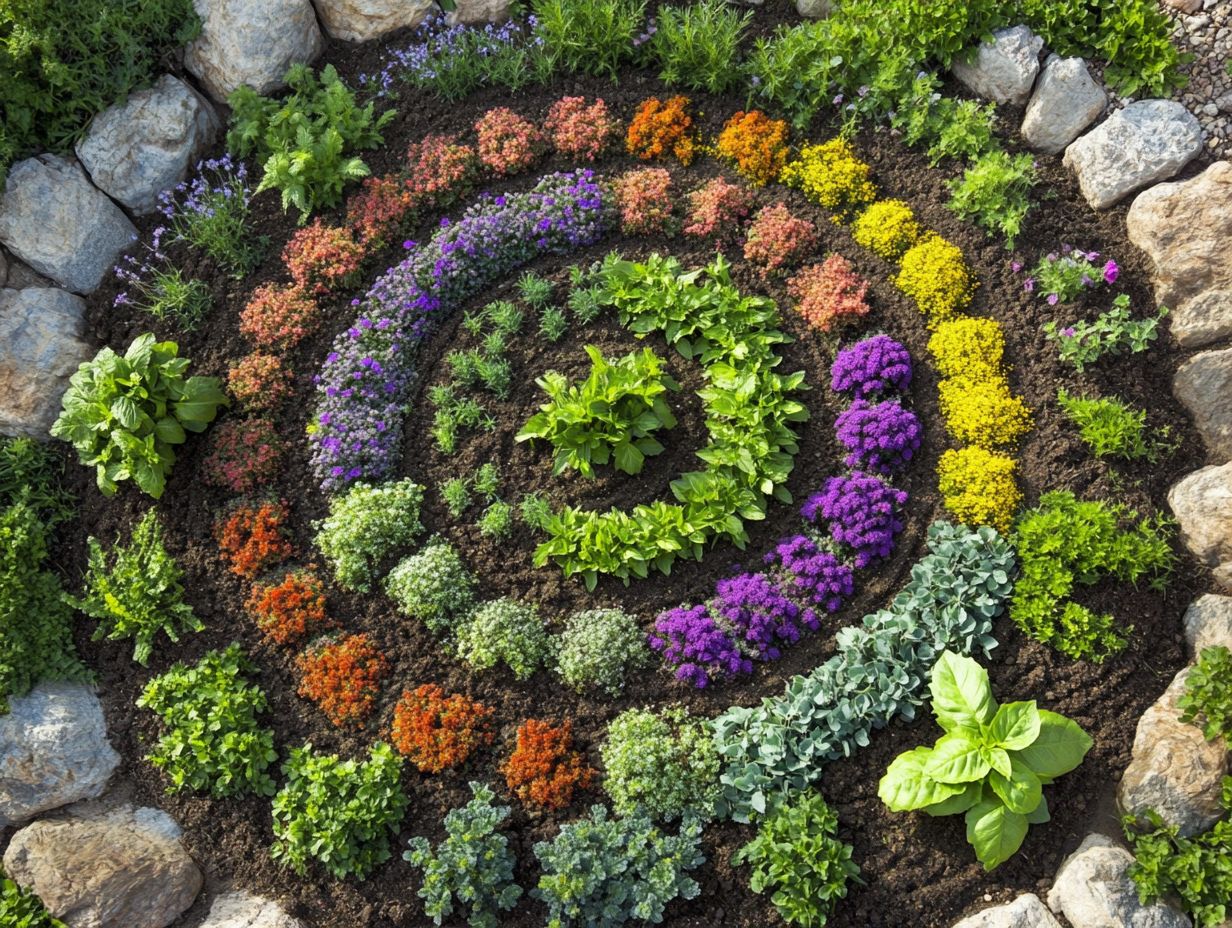
Gather materials like bricks, stones, or natural rocks to ensure both stability and effective drainage. Incorporating a variety of organic materials like compost, straw, and mulch will provide the essential nutrients your herbs need to thrive in this vertical garden design.
Selecting a location with ample sunlight is vital, as herbs flourish in well-drained soil and require a minimum of six hours of sunlight each day.
Once you ve collected your materials, take the time to plan the layout and determine the size of the spiral based on your available space and the herb varieties you wish to cultivate.
Building a sturdy base is the first step, followed by layering the stones to create increasing heights for optimal drainage. Finally, fill the structure with your chosen soil mix, allowing for diverse planting zones that cater to the unique needs of each herb.
Maintaining a Herb Spiral
Regular maintenance is crucial for your herb spiral’s success. Make sure your plants get enough water and nutrients to create an environment that promotes healthy growth and flourishing greenery.
Pruning and Harvesting Tips
Effective pruning and harvesting techniques are essential for maximizing yield and ensuring the ongoing health of the plants in your herb spiral.
By understanding the unique growth patterns and requirements of various herbs, you can improve both flavor and productivity. For example, when pruning basil, aim to cut stems just above a leaf node; this encourages bushier growth. Timing your cuts right in the season can result in a more concentrated flavor.
When harvesting herbs like thyme or oregano, opt for snips rather than tearing. This approach prevents damage and encourages rapid regrowth.
The crux of the matter lies in understanding that proper timing whether in spring or just before flowering is pivotal in maintaining optimal health and vitality for long-term yields.
Common Mistakes to Avoid
When you embark on creating a herb spiral, steering clear of common pitfalls like overcrowding and improper drainage can profoundly influence your herb garden’s success.
Embrace these crucial practices to ensure your plants thrive in their new environment, allowing your garden to flourish beautifully.
Overcrowding and Improper Drainage
Overcrowding plants in your herb spiral creates fierce competition for resources. Poor drainage may lead to root rot and a host of other complications.
When your plants are vying for nutrients, water, and sunlight, their growth can suffer, resulting in weaker specimens that are more vulnerable to diseases. To avoid these issues, space your plants appropriately, allowing each one the opportunity to flourish without unnecessary rivalry.
Establishing proper drainage is crucial; incorporating materials like gravel or sand can enhance water flow and prevent poor air circulation. Regularly monitoring the soil’s moisture level will enable you to catch potential problems early, promoting a healthier and more productive herb spiral.
Frequently Asked Questions
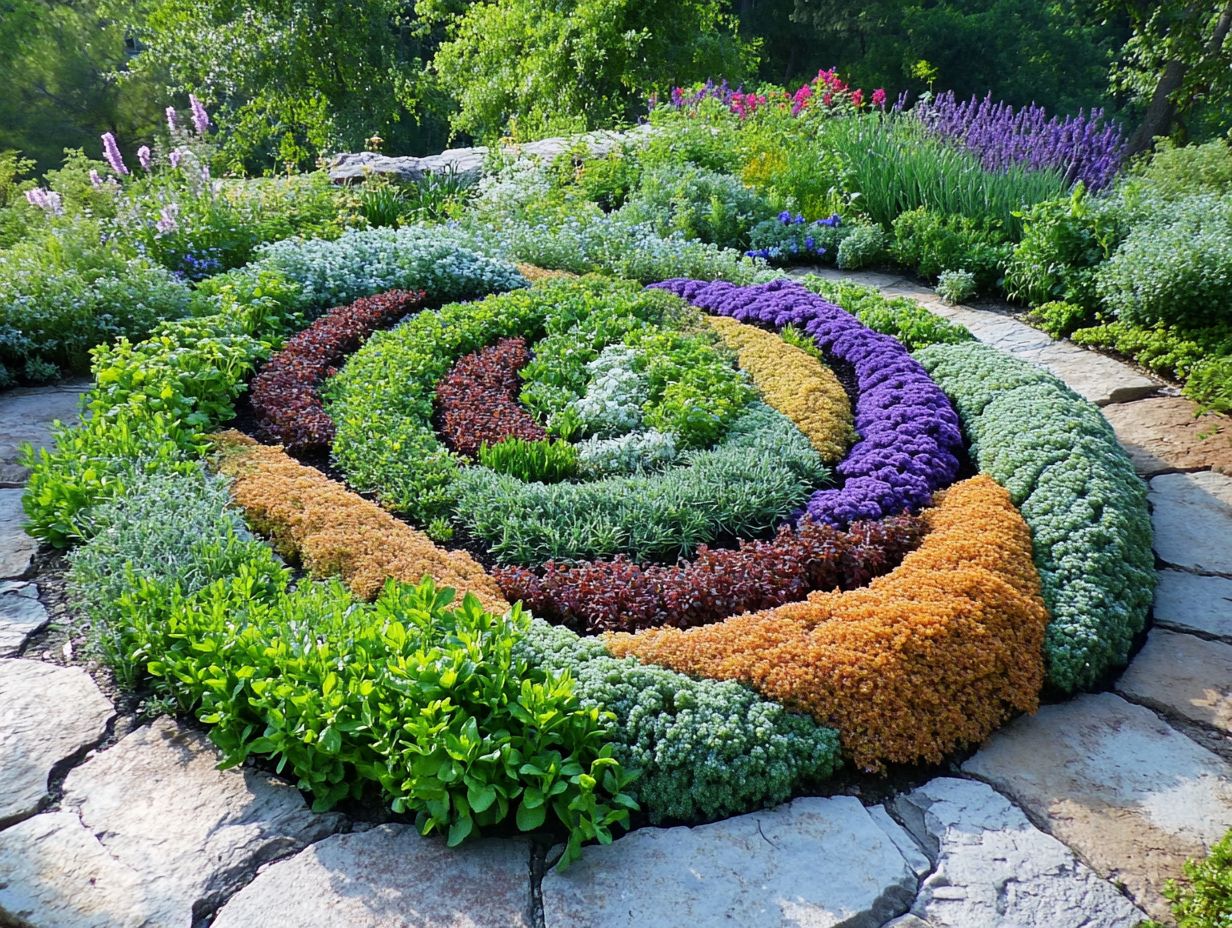
What s a herb spiral, and why is it perfect for my garden?
A herb spiral is a spiral-shaped raised bed used for growing herbs. It is a space-saving and visually appealing way to grow a variety of herbs in a small area. Choosing specific plants for your herb spiral ensures successful growth and an abundant harvest.
What factors should I consider when choosing plants for a herb spiral?
The first factor is the climate and location of your herb spiral. Some plants thrive in hot and sunny areas, while others prefer cool and shady spots. You should also consider the height and width of the plants, as well as their growth habits and compatibility with other herbs in the spiral.
Can I choose any type of herb for my spiral?
You can choose any herb for your spiral. However, select herbs that suit your climate and location.
Consider the amount of sunlight and water each herb requires. Also, think about their growth habits and compatibility with other herbs.
Do I need to choose both annual and perennial herbs for my spiral?
It is not necessary to have both annual and perennial herbs in your spiral. However, it can be beneficial.
Annual herbs provide a quick harvest. You can replant them each year.
Perennial herbs, on the other hand, offer a continuous supply. They grow back every year.
Is it possible to grow a herb spiral indoors?
Yes, you can grow a herb spiral indoors. Just ensure you have enough space and proper lighting.
You may need to adjust the types of herbs you choose to fit the indoor environment.
Can I choose herbs for my spiral based on their medicinal properties?
Absolutely! Many herbs are not just tasty; they also have amazing healing properties.
Do some research on the medicinal benefits of different herbs. Choose ones that align with your needs and preferences.

